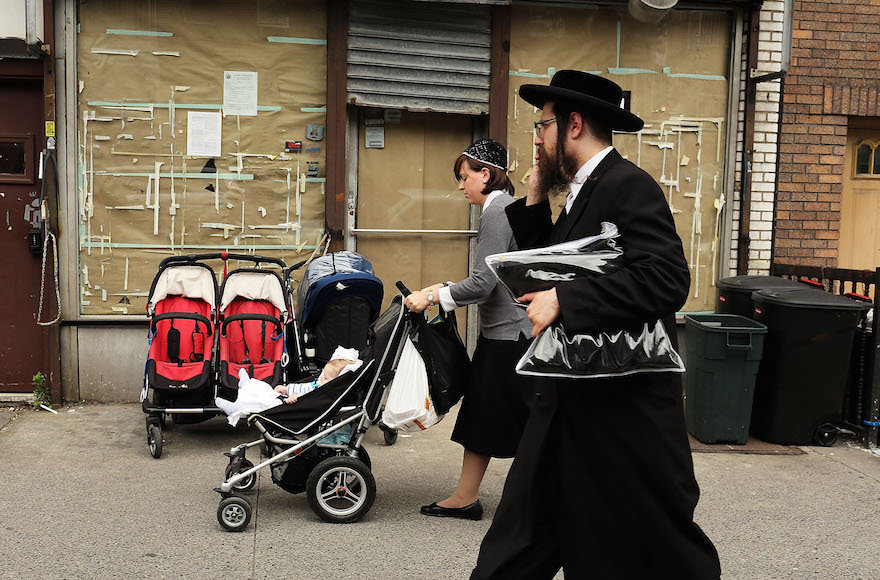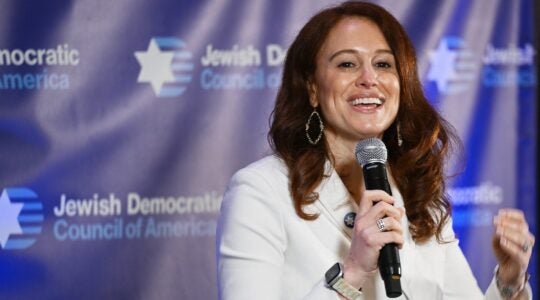NEW YORK (JTA) – Ever since the Pew Research Center released its landmark 2013 survey of U.S. Jewry, the study has become central to debates about everything from intermarriage to Jewish education. Now comes a new treasure trove of data from Pew about Orthodox Jews, extrapolated from the data amassed for the 2013 study (from 3,475 interviews with Jews conducted that year).
Though Orthodox Jews comprise only 10 percent of all American Jews, their share of the U.S. Jewish population is growing rapidly. And the implications are profound. “If the Orthodox grow as a share of U.S. Jews, they gradually could shift the profile of American Jews in several areas, including religious beliefs and practices, social and political views and demographic characteristics,” the new study says.
Here are some of the top findings in Pew’s new report, “A Portrait of American Orthodox Jews.”
About two-thirds of Orthodox Jews identify as haredi. About 62 percent identify as haredi Orthodox (Hasidic or non-Hasidic), and 31 percent identify as modern Orthodox. Seventy percent of Orthodox Jews say they were raised Orthodox, 12 percent were raised Conservative and 5 percent Reform.
Orthodox Jewry is growing rapidly. Among parents who have children, the Orthodox birth rate is 4.1 children per family, compared to 1.7 among the non-Orthodox. And almost half of all Orthodox parents have four or more children (48 percent), compared with just 9 percent of other Jewish parents.
Not everyone believes in God with absolute certainty. Orthodox Jews represent the only Jewish denomination where a majority of members believe in God with absolute certainty (96 percent of haredim and 77 percent of modern Orthodox). Among Conservatives the figure is 41 percent and among Reform 29 percent.
READ: 1 in 6 Jews are new to Judaism – and 9 other new Pew findings
Modern Orthodox Jews make more money than other Jews. Thirty-seven percent of modern Orthodox Jews report household incomes of $150,000 or more per year, compared to 29 percent of Reform Jews, 24 percent of haredi Jews, 23 percent of Conservative Jews and 22 percent of Jews of no denomination. On the poorer end of the spectrum, 43 percent of haredim report less than $50,000 annual income for their household, compared to 30 percent of modern Orthodox and 31 percent of other Jews.
Orthodox Jews are mostly Republicans. The share of those who identify as Republicans or lean Republican was, as of 2013, 58 percent of haredim, 56 percent of modern Orthodox, 27 percent of Conservative and 17 percent of Reform.
Some Jews who call themselves modern Orthodox skip key rituals. Ten percent of modern Orthodox Jews in the survey said they did not fast on Yom Kippur, 22 percent don’t always or usually light Shabbat candles, and 17 percent don’t regularly keep kosher. On the question of whether they attend religious services weekly or more often, 67 percent of modern Orthodox Jews responded in the affirmative, compared to 60 percent of haredim and only 6 percent of all other Jews (13 percent among Conservative, 4 percent among Reform and 3 percent among Jews of no denomination).
Higher educational degrees are rare among haredim. About 38 percent of haredim have a high school diploma or less, and only 25 percent have a bachelor’s degree or higher. By contrast, 60 percent of non-Orthodox Jews have a bachelor’s degree or higher. Among modern Orthodox, levels of education are more similar to other Jews than to haredim: 65 percent of the modern Orthodox have a bachelor’s degree or higher, and 21 percent a high school diploma or less.
Only 11 percent of haredim live outside the Northeast. Overall, 43 percent of America’s Jews live in the Northeast, with 23 percent in the South, 23 percent in the Midwest, and 11 percent in the West. The Northeast has 61 percent of the modern Orthodox population, 43 percent of the Conservative population and 36 percent of America’s Reform Jews. Only 1 percent of haredim live out West.
Orthodox Jews marry relatively young. Three-quarters of haredi Orthodox Jews marry by age 25 (75 percent), about half of modern Orthodox Jews marry by then (48 percent), while only about one-quarter of Reform Jews and 32 percent of Conservative Jews marry by that age.
READ: Pew study: Muslims to overtake American Jews by 2050
They send their kids to Jewish schools. Four out of five Orthodox Jewish parents with kids at home have at least one child in yeshiva or Jewish day school, and about three-quarters of Orthodox Jewish adults (73 percent) attended a Jewish day school or yeshiva as children (81 percent among haredim, 57 percent among the modern Orthodox). By contrast, only 17 percent of other Jews went to yeshiva or Jewish day school growing up.
Haredim hardly have any non-Jewish friends. About 97 percent of haredim say all or most of their friends are Jewish, compared to 65 percent of modern Orthodox and 26 percent of other Jews.
Jews of all denominations are proud to be Jewish. In all denominations, at least 93 percent of adherents say they’re proud to be Jewish, compared to 87 percent among Jews of no denomination. However, while 99 percent of Orthodox Jews say they have a strong sense of belonging to the Jewish people, the figures are 92 percent for Conservative, 78 percent for Reform and 53 percent among Jews of no denomination.
JTA has documented Jewish history in real-time for over a century. Keep our journalism strong by joining us in supporting independent, award-winning reporting.






